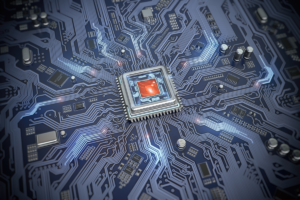It seems as though breakthroughs leading towards a traditional quantum computer occur almost daily. I say “traditional” quantum computer because the Canadian company D-Wave has already produced a computer that Lockheed Martin, Google, and NASA are convinced use quantum techniques to solve optimization problems. The D-Wave machine has been making headlines recently because of a controversy about its processing speed. [“New benchmarks raise doubt over D-Wave’s ‘quantum computer,’ but Google is optimistic long-term,” Extreme Tech, 20 January 2014] As I wrote in a previous post entitled Understanding Quantum Computing, “Let’s face it quantum computing is not an easy subject.” As an example, it takes a little mind bending for a layman to understand that a qubit can simultaneously represent both a 0 and 1. And they may find it even more difficult to believe that it would only take 300 qubits to hold all of the data that has ever been created since the big bang.
One of the challenges facing researchers seeking to develop a workable and affordable quantum computer is that stabilizing qubits has required creating processors that only work at extremely cold temperatures. This is true for the D-Wave computer. Recently, however, James Morgan reports, “A fragile quantum memory state has been held stable at room temperature for a ‘world record’ 39 minutes – overcoming a key barrier to ultrafast computers.” [“Quantum memory ‘world record’ smashed,” BBC, 14 November 2013] Morgan reports that 39 minutes is about 100 times longer than a qubit at room temperature has persisted previously.
The achievement was the work of an international team led by Professor Mike Thewalt of Simon Fraser University in Canada. They reported their work in the November issue of the journal Science. The abstract for their work states:
“Quantum memories capable of storing and retrieving coherent information for extended times at room temperature would enable a host of new technologies. Electron and nuclear spin qubits using shallow neutral donors in semiconductors have been studied extensively but are limited to low temperatures (≲10 kelvin); however, the nuclear spins of ionized donors have the potential for high-temperature operation. We used optical methods and dynamical decoupling to realize this potential for an ensemble of phosphorous-31 donors in isotopically purified silicon-28 and observed a room-temperature coherence time of over 39 minutes. We further showed that a coherent spin superposition can be cycled from 4.2 kelvin to room temperature and back, and we report a cryogenic coherence time of 3 hours in the same system.”
Morgan reports, “The team prepared the sample at -269C, close to absolute zero – the lowest temperature possible. When they raised the system to room temperature (just above 25C) the superposition states survived for 39 minutes. What’s more, they found they could manipulate the qubits as the temperature of the system rose and fell back towards absolute zero.” Thewalt stated, “This opens the possibility of truly long-term storage of quantum information at room temperature.” Of course, opening the door and walking through it are two different things. One of research paper’s co-authors, Stephanie Simmons of Oxford University’s department of materials, admits, “There are still many hurdles to overcome before large-scale quantum computations can be performed.” One of those hurdles is that the data can only be read from the qubit when it is frozen. Nevertheless, the achievement was a remarkable advance.
Another recent breakthrough was achieved by Andreas Reiserer, Stephan Ritter, and Gerhard Rempe. They were able to take advantage of a “quantum physics … loophole involving the wave-like character of photons” to detect photons without destroying them. [“Counting photons without destroying them,” by Matthew Francis, Ars Technica, 14 November 2013] Francis reports, “Non-destructive measurements would be a boon to quantum computing and communication, which frequently rely on photons but often lose many of them due to inefficiencies.” Francis reports that the experiments conducted by Reiserer, Ritter, and Rempe were “efficient enough to demonstrate the principle of non-destructive measurement. The implications are striking. This is the first demonstration of a photon counter that doesn’t require absorption. The method is tricky enough that it can’t be used in all applications, but it could prove useful in quantum optics, entanglement experiments, and quantum computing, especially logic gates based on photons.”
By now you should have a pretty clear understanding that creating a traditional quantum computer is going to be difficult. But the following video of a talk provided by Michelle Simmons at TEDxSydney in June 2012 provides an excellent overview of why the pursuit of quantum computers is so intense, what had been achieved at the time of her talk, and how much there is left to do.
Jesse Emspak writes, “Quantum computers could crack codes and run more complex simulations than current machines, but actually building one is hard to do. The bits that store this complex data don’t last long, because they are made of single atoms that get knocked around by stray electrons and photons in the environment.” But, Emspak reports, thanks to a team of physicists at Germany’s Karlsruhe Institute of Technology, we may be a bit closer. [“Quantum Computer Technology May Advance Using Rare Holmium Atoms, Scientists Say,” Huffington Post, 14 November 2013] Emspak explains:
“They found a way to get the bits to last long enough to do computations … using the magnetic properties of a rare earth element called holmium and the symmetry of platinum. The experiment, detailed in [the 14 November 2013] issue of the journal Nature, is an important step in creating quantum computers and making quantum memory useful.”
The German team was able to stabilize their qubit for about ten minutes but the equipment had to operate at near absolute zero temperatures. Because the symmetry of the spins associated with electrons of holmium and platinum atoms are different, “the holmium atoms are ‘invisible’ to the electrons moving through the platinum.” That’s why they are more stable than other types of qubits. The team is looking at other elements to discover similar relationships.
Other global advances that have been made recently include the generation of “photons — the quantum particles of light — with only one color. This is useful for quantum information.” [“Highly stable quantum light source for applications in quantum information systems,” Space Mart, 7 November 2013] “This new scheme — through its highly effective removal of the charge noise — potentially enables a stable single-photon source and may lead, for example, to improvement in semiconductor-based spin qubits.” In another breakthrough, an article published in the journal Nature “suggests that a common blue pigment, which is used in the British £5 note, can be used as a low-cost organic semiconductor, ideal for use in quantum computing. The pigment, which is called copper phthalocyanine, has electrons that can remain in a state known as ‘superposition’ — a quantum effect, where each particle exists in two states at once.” [“Bank Note Ink Will Help Make Quantum Computers Cheaper,” by Jamie Condliffe, Gizmodo, 30 October 2013]
Laura Ost reports that “physicists at the National Institute of Standards and Technology (NIST) have ‘entangled’ — linked the properties of — a microscopic mechanical drum with electrical signals.” [“NIST physicists ‘entangle’ microscopic drum’s beat with electrical signals,” National Institute of Standards and Technology press release, 3 October 2013] “The results confirm that NIST’s micro-drum could be used as a quantum memory in future quantum computers, which would harness the rules of quantum physics to solve important problems that are intractable today. The work also marks the first-ever entanglement of a macroscopic oscillator, expanding the range of practical uses of the drum.” A group of Yale scientists believes that “light might be able to play a bigger, more versatile role in the future of quantum computing.” [“In quantum computing, light may lead the way,” by Eric Gershon, Phys.org, 8 October 2013] Gershon explains:
“A team of Yale physicists has coaxed an unprecedented number of light particles, or photons, to behave quantum mechanically, or to assume more than one state simultaneously, such as ‘alive’ and ‘dead.’ In this case, the light is in the form of trapped microwave photons. Control over a greater number of photons — more than 100 in this case — raises the possibility that such states of light could play the part of several quantum bits (qubits) potentially minimize the physical scale and cost of building a quantum computer.”
In another effort, “Dr. Winfried Hensinger, along with postdoctoral fellow Simon Webster and PhD students Seb Weidt, Kim Lake, and James McLoughlin, who form part of Dr. Hensinger’s Sussex Ion Quantum Technology Group, have come up with an extremely efficient and easy way to shield the quantum computer from external noise, effectively enabling large-scale operation of a microwave quantum computer. Their paper is published in the journal, Physical Review Letters (04 October 2013).” [“Scientists take a quieter step closer to first practical quantum computer,” Phys.org, 9 October 2013] Undoubtedly I haven’t captured all of the recent advances that have been made. Nevertheless, the advances discussed provide a fairly good indication that progress continues to be made. In Part 2 of this series, I’ll discuss how graphene and light are predicted to help advance the march toward quantum computing.




